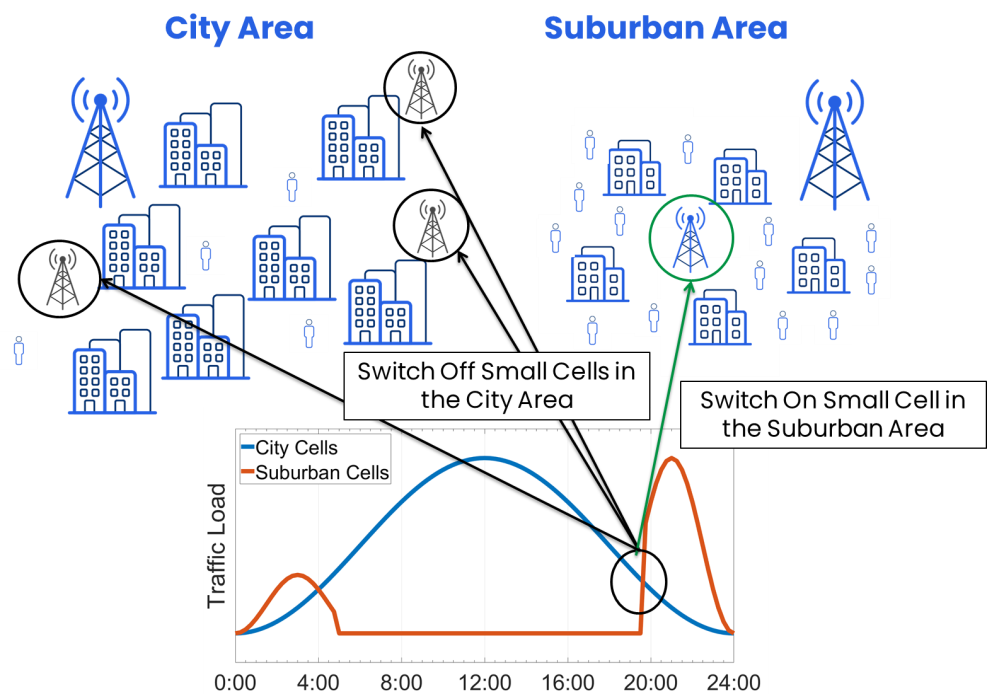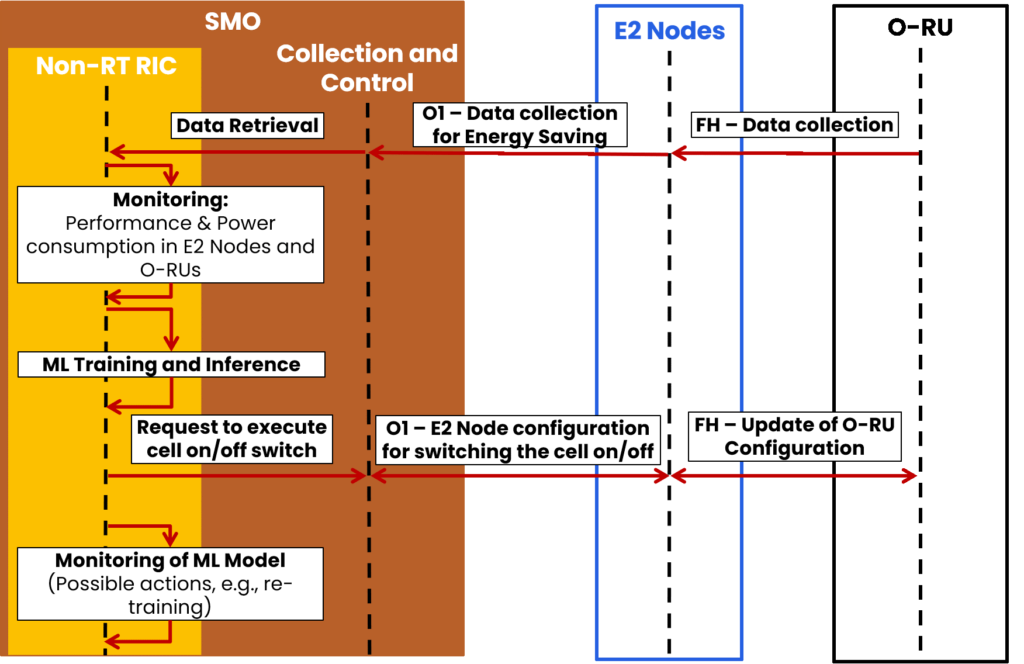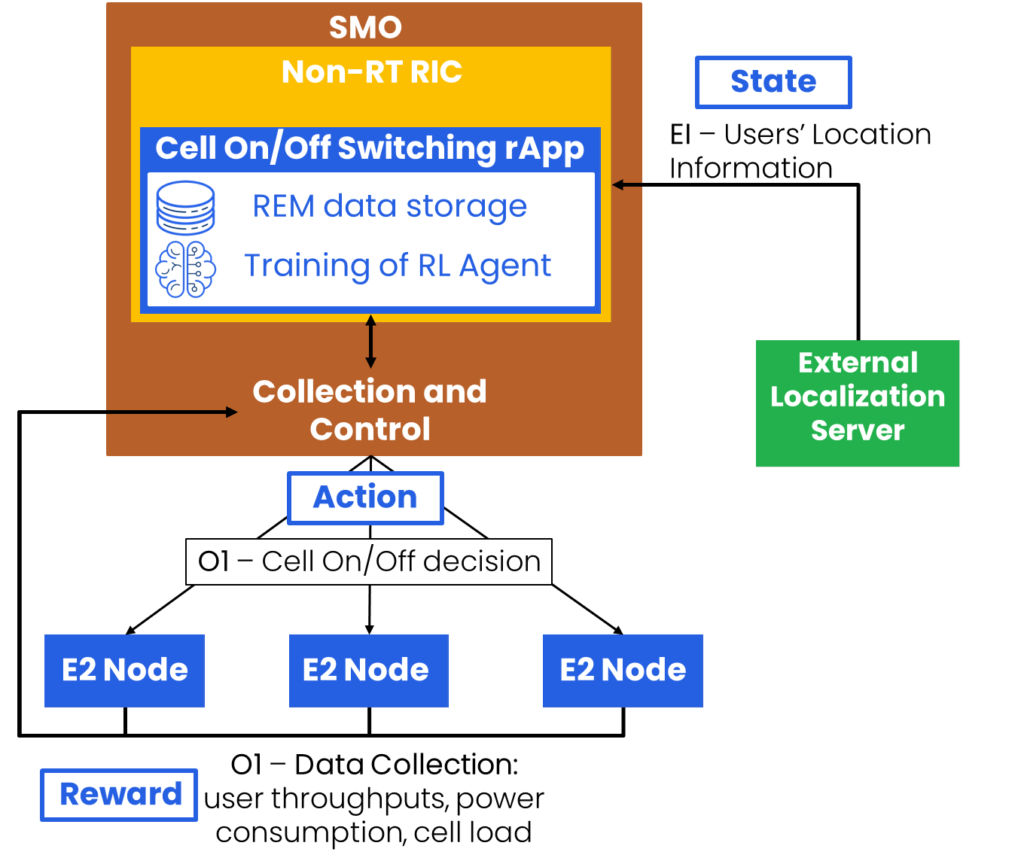O-RAN Network Energy Saving: Cell Switching On/Off
Introduction to O-RAN Network Energy Saving
The contemporary 5G wireless networks offer high throughputs by increasing the bandwidth, network densification, and utilization of advanced transmission techniques, e.g., Massive MIMO [1]. However, those techniques are associated either with the deployment of new Base Stations (BSs) or with extending existing ones with additional hardware. This results in increased power consumption, which is further related to higher Mobile Network Operator (MNO) costs, and carbon footprint [2]. From this perspective, the Energy Efficiency (EE) of 5G networks is of high importance for the telecom industry. Moreover, significant effort has been put in during the standardization phase of 5G New Radio (NR) by 3GPP to provide unified mechanisms aimed at providing MNOs with network energy savings [3]. At the same time, to enable intelligent, case-dependent optimization of EE, possibly with the use of ML techniques algorithms need access to network interfaces for monitoring Key Performance Indicators (KPIs) and control actions. This can be achieved while following the concept of O-RAN, which provides standardized interfaces to communicate with RAN components, e.g., gNB [4].
In our previous blog post (O-RAN as an Enabler for Energy Efficiency in 5G Networks) we provided a general overview of EE in the context of the 5G networks and discussed some possible techniques aiming at the improvement of EE, e.g., BS (cell) on/off switching, or antenna selection for M-MIMO. We also highlighted the significance of O-RAN architecture in the possible implementation of those algorithms. Recently, O-RAN ALLIANCE has released the updated version of its Use Case Detailed Specification [5]. One of the newly defined use cases is related to O-RAN network energy saving, and improvement of EE through the load-dependent cell on/off switching.
In this blog post, we provide the description of an algorithm that can be realized as an rApp in the O-RAN architecture aimed at improving the network’s EE through the intelligent cell on/off switching. First, we provide a general framework for long-timescale EE optimization which can be done in Non-RT RIC as defined in [5]. We then propose the implementation of the Cell On/Off Switching algorithm within the O-RAN framework. Finally, we discuss some opportunities and challenges.
Cell Switching On/Off Concept
The traffic load varies in the mobile network over the daytime, or even on different days of the week. It is related to the users’ mobility and behavior, e.g., from Monday to Friday people work in the city, thus usually BSs therein are highly loaded starting from the morning until the afternoon. On the other hand, a lot of people have their homes in the suburbs, thus BSs deployed therein remain almost empty until the late afternoon. This creates an opportunity to switch off either entire cells or some of the operating frequencies (i.e., carriers) to provide energy savings. Figure 1 depicts such an example using switching on/off cells in different parts of the considered area taking into account the daily traffic pattern.

Cell Switching On/Off in the O-RAN Architecture
O-RAN ALLIANCE proposed a high-level framework for the long-scale (of minutes, hours, and above) EE optimization in Non-RT RIC through intelligent on/off switching of cells. The information flow between O-RAN entities for on/off switching of cells based on ML inference in Non-RT RIC is depicted in Figure 2. This figure is a simplified version of the corresponding figure from the O-RAN specification [5].

According to Figure 2, the process of cell switching in O-RAN architecture can be summarized as follows:
- First, the E2 Nodes are being configured by the Service Management and Orchestration (SMO) to report the data necessary for energy-saving algorithms via the O1 Interface to the Collection and Control unit. The Non-RT RIC further retrieves the collected data through internal SMO communication.
- To collect the data E2 Nodes must adequately configure the Open RAN Radio Units (O-RU) to report the data through the Open RAN Fronthaul Management Plane (Open FH M-Plane) interface. As EE takes into account both, users’ Quality of Service (QoS), and energy consumption, the following data are of high importance: per cell (per carrier) power consumption, user throughputs, users traffic type (e.g., indicated by the 5QI), per slice radio resource utilization, etc.
- In Non-RT RIC the collected data is subject to monitoring, i.e., some long-timescale statistics of cell load, user throughputs, and related power consumption are obtained.
- The obtained long-term statistics are used to train the ML model, and after the training, phases are utilized for the ML inference.
- When ML inference results in a decision of switching specific cells on/off, the Non-RT RIC sends a proper execution request to the Collection and Control Unit via internal SMO communication.
- After receiving the request to switch a particular cell on/off from Non-RT RIC the Collection and Control unit proceeds with the proper configuration of the E2 Nodes through the O1 interface.
- Based on the configuration from the Collection and Control unit the E2 Node updates the configuration of the related O-RU.
- Finally, the utilized ML model is subject to monitoring in the Non-RT RIC, e.g., to detect degradation of its performance, and to start a re-training procedure.
Cell On/Off Switching rApp
In the literature, there is a variety of works that consider cell on/off switching in order to improve the EE of wireless networks, e.g., [6][7]. Some of them can be implemented in the O-RAN architecture in the form of rApps. In [7] we have proposed to extend the network architecture with an intelligent database named Radio Environment Map (REM), which is used to map user locations on the EE related to a particular set of active cells. In our work, the REM plays the role of data storage for the Reinforcement Learning (RL) agent, which interacts with the environment to learn which set of active cells will maximize EE for a given group of network users. REM can have a form of a lookup table when Q-Learning is employed [7], or it can contain a so-called replay buffer and neural network to be used with a Deep Q-Learning [8].
Let’s now propose, how to map our algorithm from [7] into the O-RAN architecture taking into account a use case defined in [5]. Our solution described in [7] can be hosted within the Non-RT RIC as an rApp, to interact with the other O-RAN entities in an RL cycle as depicted in Figure 3. The RL cycle starts with the recognition of the state by the agent. In the case of Cell On/Off Switching rApp, the state is represented by the set of users’ positions reported to the Non-RT RIC from the External Application Server as Enhancement Information (EI). Later on, based on the current knowledge, and algorithm parameters, the agent takes the action, i.e., sends switch on/off decisions to the given E2 Nodes over the O1 interface managed by the Collection and Control entity of SMO. Finally, the current configuration of active cells is evaluated in terms of EE, by collecting information about user throughputs and power consumption. This data constitutes a so-called reward. After the reward is obtained the RL cycle repeats from obtaining new users’ positions.

Conclusions
The EE improvement recently became one of the key directions in the field of wireless communications. However, to provide significant network energy savings, dedicated case-dependent algorithms should be deployed. These are expected to utilize ML techniques in order to, e.g., switch on/off cells on the basis of long-term characteristics of traffic load, or user mobility. However, the implementation of such algorithms requires both data collection and control actions in RAN.
This can be achieved within the O-RAN architecture that provides unified interfaces and a standardized framework for improving the EE of mobile networks with the use of ML models hosted in Non-RT RIC. The O-RAN architecture becomes a key enabler for the implementation of recent ideas published by researchers in the form of rApps/xApps. In this post, we have described Cell On/Off Switching rApp adapted by Rimedo Labs engineers from an academic idea to fit the O-RAN architecture. The implementation of rApp rises the next challenges. First, to perform cell on/off switching the rApp must strictly cooperate with other Rimedo Labs xApps, e.g., Traffic Steering (see Policy-based Traffic Steering xApp Implementation within O-RAN). Before the cell is switched off, users must be re-assigned to neighboring cells. The cell switching can be centralized, which gives potentially the highest EE gains, yet increases the computational complexity of the rApp, i.e., the number of possible active cell combinations grows exponentially. On the other hand, a decentralized solution requires less extensive computations. However, it requires somehow clustering cells into the areas being controlled by a single Cell On/Off Switching rApp.
References
[1] A. Gupta and R. K. Jha, „A Survey of 5G Network: Architecture and Emerging Technologies,” in IEEE Access, vol. 3, pp. 1206-1232, 2015, DOI: 10.1109/ACCESS.2015.2461602.
[2] M. Masoudi et al., „Green Mobile Networks for 5G and Beyond,” in IEEE Access, vol. 7, pp. 107270-107299, 2019, DOI: 10.1109/ACCESS.2019.2932777.
[3] 3GPP TS 28.310 V17.3.0, “3rd Generation Partnership Project, Technical Specification Group Services and System Aspects, Management and orchestration, Energy efficiency of 5G” Release 17, December 2021
[4] M. Dryjanski, R. Lundberg, “The O-RAN Whitepaper; Overview, Architecture, and Traffic Steering Use Case”, 2021, https://www.rimedolabs.com/blog/the-o-ran-whitepaper/
[5] O-RAN Alliance, “O-RAN Working Group 1 Use Cases Detailed Specification” v09.00, October 2022
[6] M. Hoffmann, A. Kliks, P. Kryszkiewicz, and G. P. Koudouridis, “A Reinforcement Learning Approach for Base Station On/Off Switching in Heterogeneous M-MIMO Networks,” 2020 IEEE 21st International Symposium on “A World of Wireless, Mobile and Multimedia Networks” (WoWMoM), 2020, pp. 170-172, DOI: 10.1109/WoWMoM49955.2020.00038.
[7] M. Hoffmann, P. Kryszkiewicz, A. Kliks “Increasing energy efficiency of massive-MIMO network via base stations switching using reinforcement learning and radio environment maps” Computer Communications, 2021, pp. 232-42.
[8] M. Hoffmann and P. Kryszkiewicz, „Radio Environment Map and Deep Q-Learning for 5G Dynamic Point Blanking,” 2022 International Conference on Software, Telecommunications and Computer Networks (SoftCOM), 2022, pp. 1-3, DOI: 10.23919/SoftCOM55329.2022.9911517.
Related Rimedo Labs Resources
- The O-RAN Whitepaper: Sign up for our newsletter to download: The O-RAN Whitepaper
- Blog post on green communications: Green Communication and Computing for 2030 – RIMEDO Labs
- O-RAN Blog posts: Other blog posts regarding the O-RAN: 1. Introduction to O-RAN: Concept and Entities, 2. O-RAN Architecture, Nodes, and Interfaces, 3. near-Real-Time RIC (RAN Intelligent Controller), 4. O-RAN Use Cases: Traffic Steering
- O-RAN website: Find out more about our O-RAN offering, services and materials O-RAN
- Webinar: A video recording from a webinar discussing O-RAN architecture, RIC internals, use cases, with a special focus on traffic steering: O-RAN Architecture and Use Cases – YouTube
- Training: Sign up for our O-RAN System Training (intelefy.com)
Author Bio
Marcin Hoffmann is a Senior R&D engineer at Rimedo Labs working on O-RAN software development solutions and spectrum sharing-related projects. Marcin is a Graduate Student Member, at IEEE and received an M.Sc. degree (Hons.) in electronics and telecommunication from Poznań University of Technology, in 2019, where he is currently pursuing a Ph.D. degree with the Institute of Radiocommunications. He is gaining scientific experience by involvement in both, national and international research projects. His research interests include utilizing machine learning and location-dependent information for network management. In addition to that Marcin works on massive MIMO and advanced beamforming techniques. His scientific articles are published in the top journals like IEEE Journal on Selected Areas in Communications, IEEE Transactions on Intelligent Transportation Systems, or IEEE Access.
